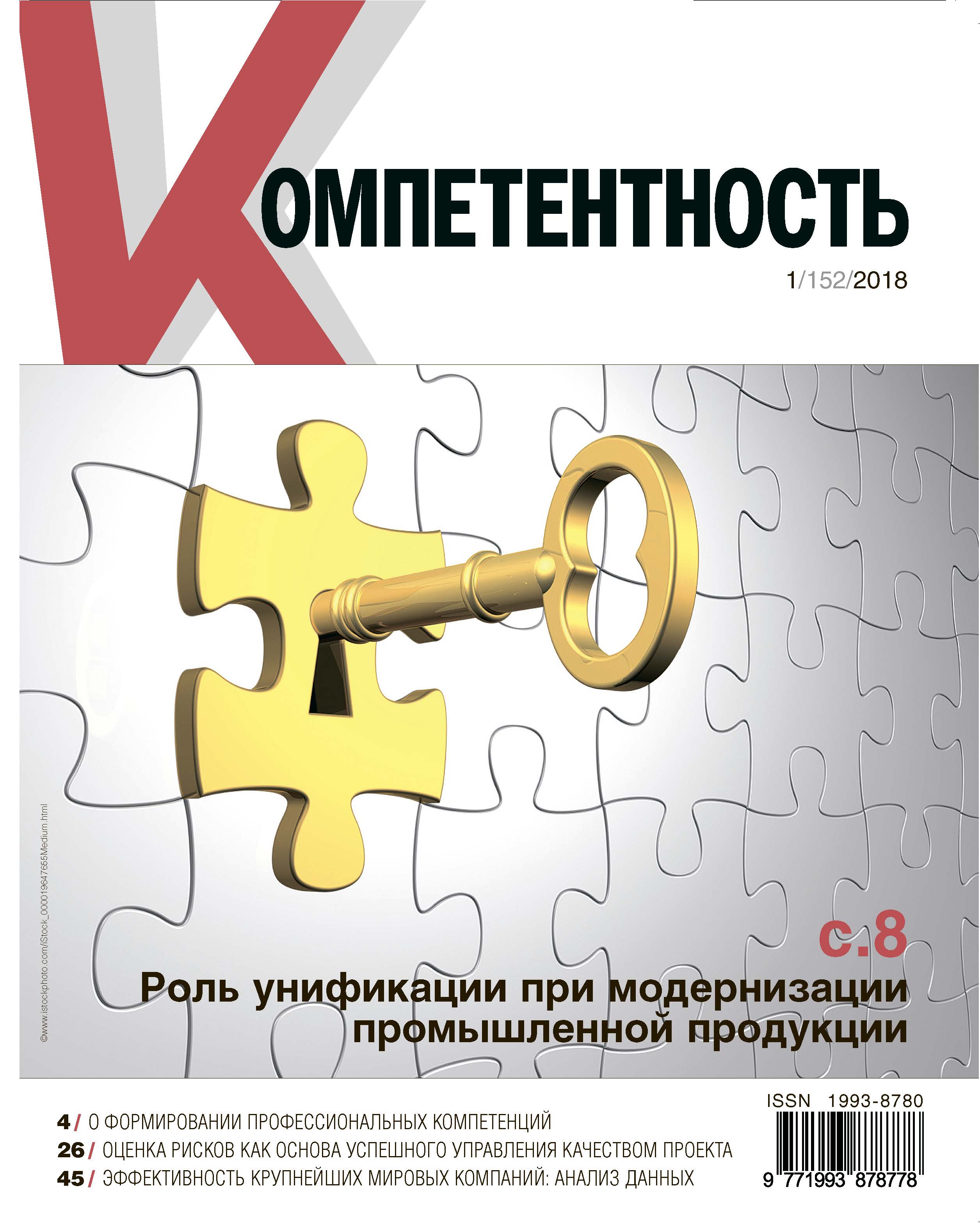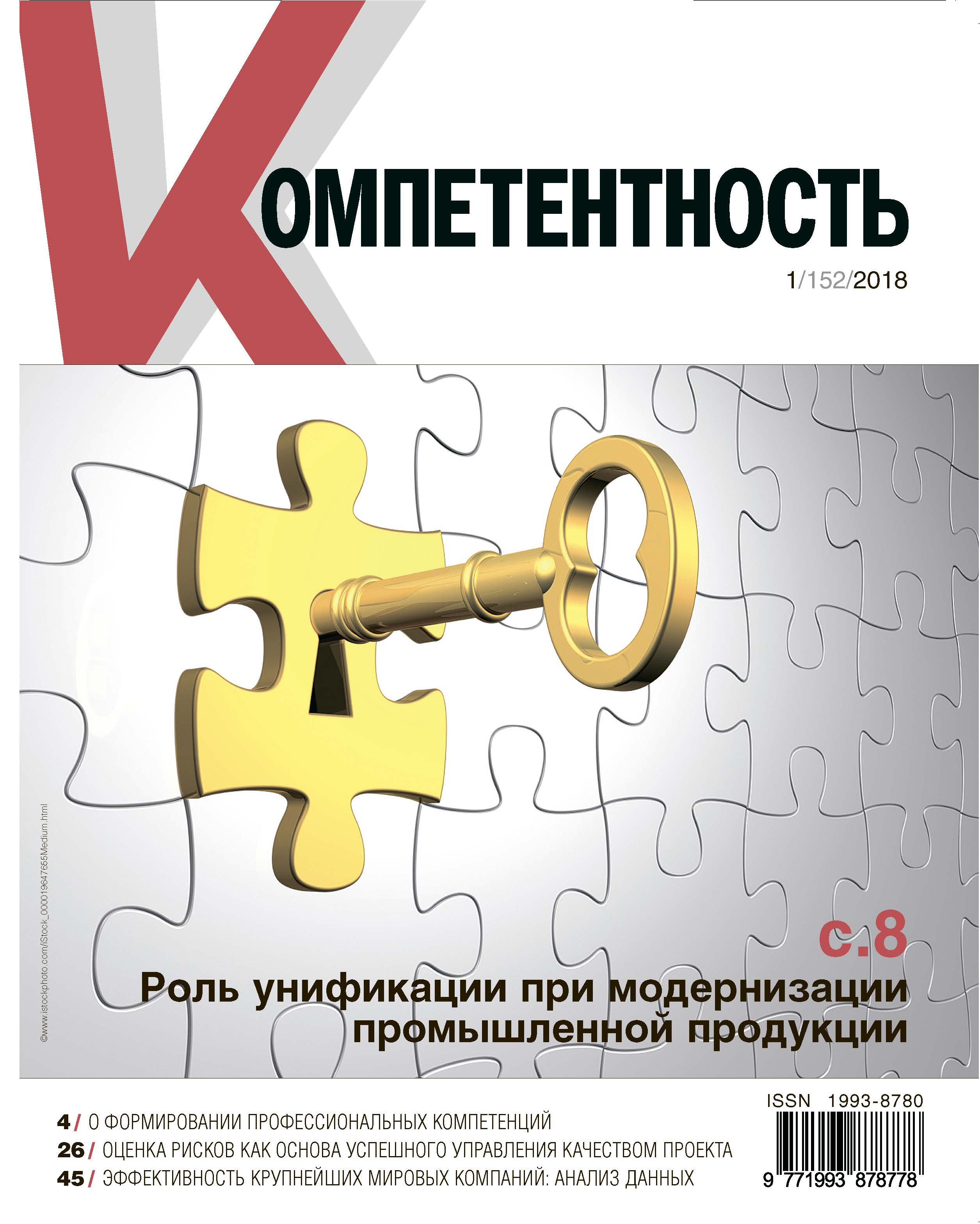Journal Kompetentnost': 1 / 152 / 2018
Articles
-
1
Formation of Professional Competencies on the Generalized Labor Functions’ Basis
Authors: Dr. Е.P. Aristova, Associate Professor, Department of Mechanics, D. Mendeleev University of Chemical Technology of Russia, Moscow, Russia, aristovaep@muctr.ru
Prof. Dr. V.М. Aristov, Vice-Rector for Teaching and Methodical Work, D. Mendeleev University of Chemical Technology of Russia, Moscow, Russia, aristov@muctr.ru
Prof. Dr. А.О. Kharitonov, Head of Department, Department of Standardization and Computer Graphics, D. Mendeleev University of Chemical Technology of Russia, Moscow, Russia, aharitonov@muctr.ru We have devoted this work to the question of forming the curricula’s professional
We have devoted this work to the question of forming the curricula’s professional
competencies in accordance with the new generation 3++ educational standards’
requirements. We have made a choice of four professional standards, corresponding
to this direction by the example of graduate training in the direction of 27.04.01
«Standardization and metrology», Master program «Standardization and certification
in the chemical industry».
We have proposed an approach for forming a block of generalized labor functions
for the definition of professional competencies based on the qualification levels
corresponding to these functions and the positions recommended by professional
standards. However, the production orientation of new professional competencies can
worsen the quality of undergraduates’ preparation for scientific work. Therefore, we
consider it is necessary to complement professional competencies, including generalized
labor functions, competencies similar to those of the current educational standard.
We believe that the proposed methodology for determining the competencies of
curricula based on the professional standards’ generalized labor functions is of interest
to specialists planning educational process in universities and can be used in practice.
Download -
2
The Role of Unification in the Industrial Products’ Modernization
Authors: Prof. Dr. A.V. Leonov, Leading Researcher, the 46th Central Scientific Research Institute of the Russian Federation Ministry of Defence, Moscow, Russia, alex.clein51@yandex.ru
Dr. A.Yu. Pronin, Senior Researcher, the 46th Central Scientific Research Institute of the Russian Federation Ministry of Defence, Moscow, Russia, pronin46@bk.ru Our research is based on the well-known encyclopedic definitions of the term
Our research is based on the well-known encyclopedic definitions of the term
modernization, emphasizing the modern constructive refinement of products. We have
shown that the modernization of industrial high-tech products is a complex scientific
and production problem. It requires a system solution taking into account a variety
of risks, factors and conditions, including unification.
We have examined the content of key stages of modernization:
(a) formation of requirements for modernized products; (b) determination of the
functional and operational-technical characteristics’ level conformity for existing
products with the requirements imposed on them; (c) formation of possible options
for the modernization of products to meet specified requirements; (d) determination
of modernization type taking into account the state of products and directions
of unification for each modernization type; (e) technical and economic assessment
of modernization options by the criterion of efficiency — costs and justification
for choosing a rational option.
We have proposed a method of economic evaluating the unification measures
effectiveness, based on a structural analysis of the costs of modernization and
establishment of those components that are most dependent on the ratio of new,
including the original, and unified components. The essence of the proposed method
consists in a comparative evaluation of the costs of development work for modernization
using only original and with the joint use of original and unified components.
In conclusion, the maximum joint use of unification and modernization potentials
becomes a priority strategy for improving and developing modern technological and
technical systems. Modernization works should be carried out systematically on
the basis of the methodology of program-target planning, taking into account the
interrelation of existing and upgraded products, as well as the results of detailed technical
and economic analysis of the whole set of measures for unification for a long period.
Download -
3
Documented Information of Quality Management System as a Products
Authors: К.I. Porsev, Postgraduate, Department of Metrology and Standardization, Moscow Technological University, Assistant, Department of Materials Technology, Standardization and Metrology Yaroslavl State Technical University, Yaroslavl', Russia, ram_dva@mail.ru
Prof. Dr. М.F. Bulatov, Head of Department, Department of Metrology and Standardization, Moscow Technological University, Moscow, Russia, bulatov_agu@mail.ru The use of documented QMS information in many organizations involves a number of
The use of documented QMS information in many organizations involves a number of
difficulties. Most of them are due to the need for daily work of personnel with a large and
continuously increasing volume of documents, which requires effective management
tools. We believe it is necessary to apply a method that would allow the creation
of documented QMS information in the form of a process for searching, identifying, and
also forming approaches to further improving the mechanisms and means of managing
this process. We are confident that in this case a process approach should be used. We
have constructed and described the scheme of the process of creating documented
QMS information in electronic form, and also analyzed the possibility of considering
the documented QMS information in the form of products.
Download -
4
Risk Assessment in the Organization’s QMS: Selection of Optimal Management Decisions
Authors: Dr. A.A. Spiridonova, Associate Professor, Moscow Technological University, Moscow, Russia, al.spiridonova@gmail.com
Dr. E.G. Khomutova, Professor, Moscow Technological University, Moscow, Russia, khomutova@mail.ru We have considered the problem of developing optimal and adequate management
We have considered the problem of developing optimal and adequate management
solutions as one of the most important stages of risk assessment in the organization’s
quality management system. This is an actual problem in the light of the formed
ideology of the new ISO 9001 standard version concerning the integration of the riskoriented
approach in the organization’s QMS.
This issue is of practical value for organizations that are only implementing QMS,
and for those already having a certificate of compliance with the ISO 9001 standard.
We have conducted a critical analysis of existing concepts in the field of risk
assessment. Basing on the accumulated experience, we have proposed an original
approach to the choice of management decisions. Proposals are based on a staged
forming the list of a preventive measures in relation to identified and assessed risks,
taking into account the principle of optimality in terms of risk to the consumer and the
organization’s resources.
Download -
5
Risk Assessment is the Basis for Successful Project Quality Management
Authors: Assoc. Prof. Dr. V.A. Novikov, Vice-Rector, FSAEI FVT Academy of Standardization, Metrology and Certification (training) (ASMS), Head of Department, Quality Management, Moscow, Russia, nva@asms.ru
Dr. E.B. Bobryshev, Associate Professor, FSAEI FVT ASMS, Moscow, Russia
Dr. E.Yu. Barmenkov, Associate Professor, MAI (National Research University), Moscow, Russia
D.B. Nosova, Specialist-Expert, Department of Licensing Activity, Licensing and Control Department of RF Ministry of Construction and Housing-Communal Services, Moscow, Russia We are confident that the basis for successful project management is a generally
We are confident that the basis for successful project management is a generally
accepted methodology for the analysis and project risks management, which using
provides a lot of advantages.
A thorough knowledge of different negative circumstances combined with the right
choice of effective tools to counter possible risks is one of the main conditions for the
success of any modern project manager.
In this paper, we have shown that the development of effective risk assessment
programs at all stages of implemented project life cycle will not only control various
undesirable events and uncertainties, but will also enable us to bypass or minimize the
damage from their consequences through timely active response. An important aspect
in proper risk management is the need to constantly monitor and update both the
register of possible risks and the list of instruments to counter them.
Download -
6
On Personnel Stimulation and Motivation in the Management System of Industrial Enterprise
Authors: О.V. Pisarenko (Vol’f), Postgraduate, Department of Applied Economics, Institute of Space Technologies of RUDN University, Chief Specialist, The Center for Design Development of FSUE NPO Tekhnomash, Moscow, Russia, OPisarenko2015@yandex.ru We have considered the actual problem of creating an innovative approach to human
We have considered the actual problem of creating an innovative approach to human
resource management in modern industrial enterprises. This problem is analyzed against
the backdrop of a deficit of various types of resources, including human resources. The
accounting of human aspect at introducing innovations is the main and fundamental
factor. The development and implementation of innovations in the management
system, particularly in motivation and stimulation system should be carried out on the
basis of a thorough analysis of the existing personnel management system, identifying
its shortcomings and opportunities, and taking into account the requirements of
the latest trends in human resources management and enterprise development. At
stimulation system development, it is necessary to take into account the interests
related to the development of plans for developing the overall organizational strategy
and enterprise policy.
Download -
7
The Practice of Applying the Standardized Work Method
Authors: Dr. V.D. Mogilevets, Associate Professor, Department of Design and Technology of Machine-Building Production, Kazan National Research Technical University named after A.N. Tupolev — KAI, Naberezhnye Chelny, Russia, mogilevec-val@mail.ru
Assoc. Prof. Dr. I.А. Savin, Head, Department of Design and Technology of Machine-Building Production, Kazan National Research Technical University named after A.N. Tupolev — KAI, Naberezhnye Chelny, Russia We have examined the experience of using the standardized work method, focused on
We have examined the experience of using the standardized work method, focused on
identifying losses and continuous improvement of the production process. From a Lean
production perspective, standardized work is a method that focuses on continuous
improvement. When we present the process in detail, we know what its value is
and where the losses are hidden, then a step-by-step improvement of this process
becomes possible. The tasks of standardized work are to achieve the best way of its
implementation, to ensure the proper level of safety, quality and productivity. We have
developed an algorithm for carrying out standardized work to perform operations of the
production process. The quality, cost of production and staff efficiency are improved
through the rapid search and detection of deviations from the standards, efficiency and
visibility of employee training.
Download -
8
Efficiency of the World’s Largest Companies: Exploration Data Analysis
Authors: А.S. Butram’eva, Certification Specialist, Certification Body MosGortTest, Moscow, Russia, nastassi95@yandex.ru
Z.G. Toyboldinova, Director, Limited Liability Partnership Ayuka Group, Almaty, Republic of Kazakhstan, t_zuhra@mail.ru
Dr. V.L. Shper, Associate Professor, National University of Science and Technology, Moscow, Russia, vlad.shper@gmail.com Using the methods of exploratory data analysis, we have recorded the correlation
Using the methods of exploratory data analysis, we have recorded the correlation
between the efficiency of domestic and foreign companies, compared how the
effectiveness of both has changed in the last ten years (from 2005 to 2015/2016).
In the course of the study it turned out that with the help of this method it is possible
to extract many important conclusions even with a limited amount of information.
In particular, we have found out that the efficiency of companies in terms of their
income does not mean that they have high rates of labor productivity.
We believe that in trying to catch up with world leaders, Russian entrepreneurs
should pay attention not only to the revenues and / or capitalization of their companies,
but also to labor productivity, expressed in indices revenue per employee and profit
per employee.
Download



